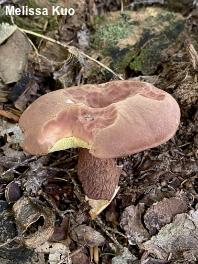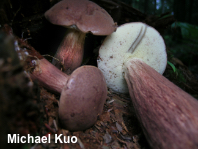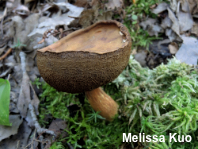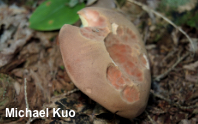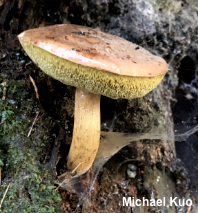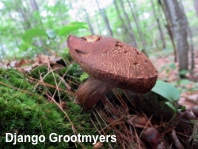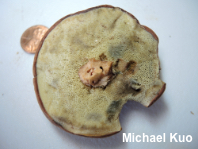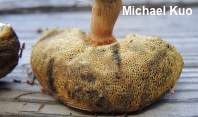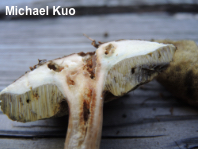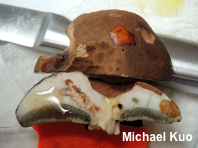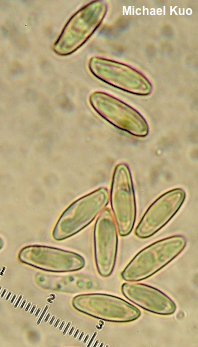| Major Groups > Boletes > Red-Capped, Blue Staining Boletes > Imleria badia |

|
[ Basidiomycota > Boletales > Boletaceae > Imleria . . . ] Imleria badia by Michael Kuo, 21 June 2023 Although several of its defining features can vary between collections, Imleria badia is a fairly easily recognized bolete. Originally described from Europe, it is also found in the conifer forests of northeastern North America, the upper Midwest, and the Appalachians, often fruiting from or around very decayed wood—and the "bay brown" color of its cap and stem contrasts elegantly with the pale yellow pore surface, which bruises bluish or grayish. The surface of the stem is distinctive, in my opinion, but is hard to describe. While the stem is not reticulate, it is also not smooth; broad, shallow wrinkles cover at least the midportion when the mushroom is young. Thanks to Django Grootmyers for documenting, collecting, and preserving Imleria badia for study; his collection is deposited in The Herbarium of Michael Kuo. Boletus badius and Xerocomus badius are former names. Description: Ecology: Mycorrhizal with conifers (especially pines and eastern hemlock), and sometimes reported under beech (especially in Europe) and birch; growing alone, scattered, or gregariously, often from or in the vicinity of well-decayed, mossy stumps; summer and fall; widely distributed in northeastern North America, the upper Midwest, and the Appalachians; also found in Mexico and Europe. The illustrated and described collections are from France, Maine, and Michigan. Cap: 3–9 cm; convex, becoming broadly convex; sticky when fresh, but soon dry; bald, with a kid-leathery feel; brown to pinkish brown or reddish brown; margin with a tiny (1–2 mm) overhanging sterile portion. Pore Surface: Pale dull yellow, becoming yellow and eventually dirty yellowish brown; bruising grayish blue; 2–3 pores per mm at maturity; tubes to 1 cm deep, olive at maturity, xerocomoid. Stem: 5–18 cm long; 1.5–4 cm thick; enlarged at the base; usually somewhat wrinkled, shallowly and longitudinally; bald; not reticulate; pale yellowish to pale brownish near the apex; brown to reddish brown below; basal mycelium white. Flesh: White overall, but sometimes pale yellow just above the tubes; unchanging when sliced, or slowly bluish pink under the cap cuticle. Odor and Taste: Odor not distinctive; taste slightly soapy. Chemical Reactions: Ammonia black on cap surface, sometimes with an initial blue-green flash; negative on flesh. KOH blackish maroon or orange on cap surface; pale orange on flesh. Iron salts negative or blackish olive on cap surface; negative to grayish on flesh. Microscopic Features: Spores 11–15 x 4–6 µm (sometimes longer when 2-spored basidia are present); boletoid-fusiform; smooth; ochraceous in KOH. Basidia 2- or 4-sterigmate. Hymenial cystidia 40–50 x 7–10 µm; lageniform to mucronate; smooth; thin-walled; hyaline in KOH. Pileipellis a collapsing and sometimes gelatinizing trichoderm; elements 5–7.5 µm wide, smooth, hyaline to ochraceous or golden in KOH; terminal cells cylindric with rounded apices. REFERENCES: Fries, 1821. (Saccardo, 1888; Coker & Beers, 1943; Snell & Dick, 1970; Smith & Thiers, 1971; Grund & Harrison, 1976; Phillips, 1981; Smith, Smith & Weber, 1981; Breitenbach & Kränzlin, 1992; Phillips, 1991/2005; Lincoff, 1992; Both, 1993; Barron, 1999; Bessette, Roody & Bessette, 2000; Nonis, 2001; Roody, 2003; McNeil, 2006; Miller & Miller, 2006; Ŝutara, 2008; Buczacki et al., 2012; Nuhn et al., 2013; Kuo & Methven, 2014; Wu et al., 2014; Zhu et al., 2014; Bessette et al., 2016; Wu et al., 2016; Baroni, 2017; Gminder & Böhning, 2017; Kibby, 2017; Knudsen & Taylor, 2018; Noordeloos, 2018; Læssøe & Petersen, 2019; Farid et al., 2020; Kibby, 2020; Kuo & Ortiz-Santana, 2020; McKnight et al., 2021.) Herb. Kuo 09110404, 07211503, 08112008. This site contains no information about the edibility or toxicity of mushrooms. |
© MushroomExpert.Com |
|
Cite this page as: Kuo, M. (2023, June). Imleria badia. Retrieved from the MushroomExpert.Com Web site: http://www.mushroomexpert.com/imleria_badia.html |
